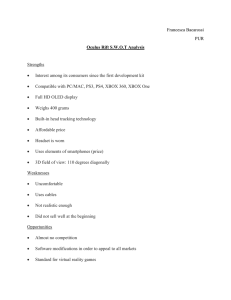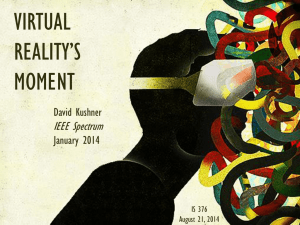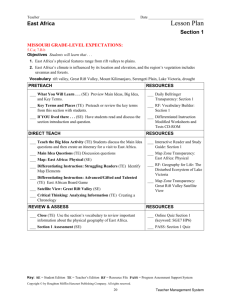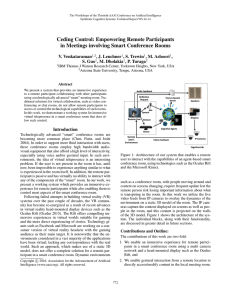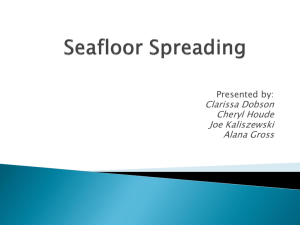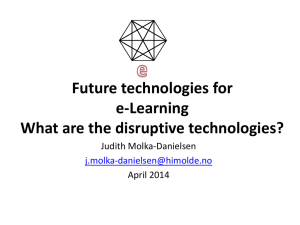Unit 3 essay
advertisement
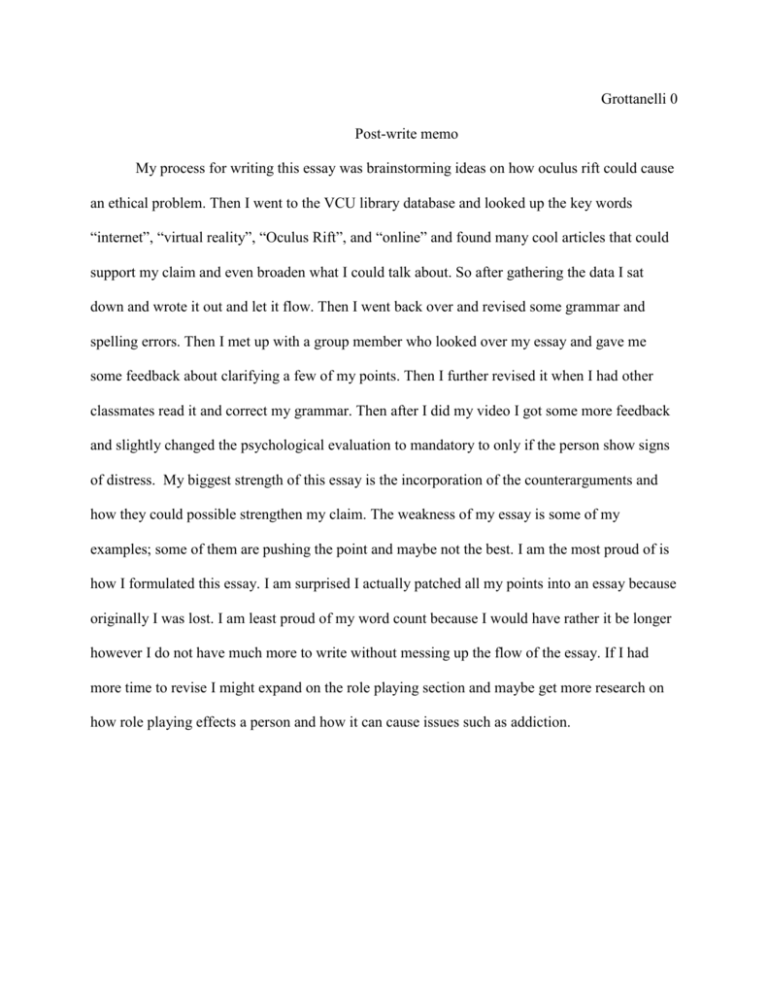
Grottanelli 0 Post-write memo My process for writing this essay was brainstorming ideas on how oculus rift could cause an ethical problem. Then I went to the VCU library database and looked up the key words “internet”, “virtual reality”, “Oculus Rift”, and “online” and found many cool articles that could support my claim and even broaden what I could talk about. So after gathering the data I sat down and wrote it out and let it flow. Then I went back over and revised some grammar and spelling errors. Then I met up with a group member who looked over my essay and gave me some feedback about clarifying a few of my points. Then I further revised it when I had other classmates read it and correct my grammar. Then after I did my video I got some more feedback and slightly changed the psychological evaluation to mandatory to only if the person show signs of distress. My biggest strength of this essay is the incorporation of the counterarguments and how they could possible strengthen my claim. The weakness of my essay is some of my examples; some of them are pushing the point and maybe not the best. I am the most proud of is how I formulated this essay. I am surprised I actually patched all my points into an essay because originally I was lost. I am least proud of my word count because I would have rather it be longer however I do not have much more to write without messing up the flow of the essay. If I had more time to revise I might expand on the role playing section and maybe get more research on how role playing effects a person and how it can cause issues such as addiction. Grottanelli 1 Serafina Grottanelli Professor Ryan Cales University 112 As gaming technologies advance in immersion the institute of gaming changes. One of the changes in the institution of gaming is the adaptation of virtual reality technologies. Like most technological advances there are great benefits but if misused they can cause detrimental issues. One of the more progressive virtual reality technologies is Oculus Rift. Oculus Rift is an electrical pair of goggles that have surround sound, upfront visuals, motion sensors, and camera. Its purpose is to give the user the feeling of actually being there, either in the game, or the virtual simulation. Due to the immersive qualities and the comparative data collected from video games, there needs to be a policy or set of codes for individuals, who may show risk of psychosis or just have issues separating reality from virtual reality. In this essay we will strengthen the understanding of why there is cause for a policy and the comparative aspects it has with videogames. Starting off like most new technologies there are many benefits to immersive technologies such as Oculus Rift. Even though originally Oculus Rift was being used for gaming it is also used to put someone in a virtual reality. Virtual reality is being used in the psychological world, by trying to help people who suffer from Social Anxiety, Panic Disorder, Agoraphobia, and Autism. According to “Cybertherapy: Internet and Virtual Reality as Assessment and Rehabitation Tools for Clinical Psychology and Neuroscience” by Bortella, Villa, Garcia-Palacios, Quero, Banos, and Alcaniz the VEPSYupdated project they looked over clinical protocols of virtual reality to see how effective using VR in a cognitive-behavior Grottanelli 2 program is at treating patients who suffer from panic disorder with agoraphobia (PDA)”… Our findings support the efficacy and effectiveness of VR for the treatment of PDA…” (74) So therefore this strengthens the argument that traits or habits we pick up in the virtual realty transfer to reality, because in this particular experiment, the therapy used in the virtual reality was strong enough to transfer and stick with the patient in realty. According to “Virtual-RealityBased Social Interaction Training for Children with High-Functioning Autism” by Ke and Im “The study has used Second Life as a VR platform for both verbal and nonverbal communication… subjects’ nonverbal communication performance was improved throughout the training…”(20) Second Life is a specific program using virtual reality that mimics reality, so a “second life” or an alternative life from what you live in. In this particular study it also shows how traits picked up in the “second life” carried over into reality. Also, what strengthens this argument is the fact the changes where not only observed by the psychologist but also the parents of the children. It should also be noted that the changes in this particular case are satisfactory, because the virtual reality helped these individuals out in reality by helping their social skills. So the significance of this experiment is depending on what is being shown in the virtual reality and how this could affect us in reality either in a negative or positive way. Therefore there should be a policy or code dealing with people, who show signs of having extreme negative consequences such as instead of improved social skills become even more reclusive or a type of avoidant disorder. Since psychology is already being mixed with virtual reality, maybe there could be virtual psychology offices in the virtual worlds to help people who are seeking help. Therefore there would be a voluntary option, plus since it is virtually done and not a real-life interaction, it may be easier for people to talk to someone. Grottanelli 3 Another benefit of these virtual reality technologies is that with some modifications burn victims can now use Oculus Rift to lower their pain intensity. In “Feasibility of Articulated Arm Mounted Oculus Rift Virtual Reality Goggles for Adjunctive Pain Control During Occupational Therapy in Pediatric Burn Patients” by Hoffman, Meyer III, Ramirez, Roberts, OTR, Seibel, Atzori, Sharar, Patterson says what was observed when the burn victim used Oculus Rift: “His rating of pain intensity during therapy dropped from severely painful during no VR to moderately painful during VR… He reported going ‘completely inside the computer generated world’, and had more fun during VR. Results are consistent with a growing literature showing reductions in pain during VR.” (1) So not only does this show the decreased pain in that individual case, but it also shows there are more studies that support this research. It also proves that going into a virtual reality pulls a person further from reality. Which in these situations is a good thing, because it reduces the pain felt and could cause a faster recovery, but in ordinary cases, is the level of immersion a good thing? Since Oculus Rift is an immersive technology it can share some of the same benefits and therefore consequences. One of the consequences is the fact it is almost fully immersive and therefore can be addicting. The pleasure and the pain that happen in game can transfer into the real world. With the case with helping high functioning autistic patients when in the virtual reality the children often showed “facial expressions and … were filled with exuberance…”(18) showing that there is still a link between virtual reality and reality with emotions and expressions. It also shows the level of immersion without Oculus Rift it would be equivalent to a Sims game or something. Also, another similar example is the children are often asked to be able to spend more time in their virtual reality, showing the addictive qualities virtual reality presents. Grottanelli 4 Another thing to consider in these particular situations the settings are used in the experiment were school and party settings, but since it was an isolated virtual reality there were not bullies or other infuriating people who would normally be at or in those situations. So, therefore, these experiments may not cover the true experience of virtual reality. In these situations also roleplaying was a huge key to these changes. Often when a person is role-playing they often act out how they would like to handle a particular system or how their character they design reacts to the situation. Role-playing itself is a good thing it allows people to act out situations in certain environments and see how the actions could potential effect others, the problem comes to hand when the person’s whole life is in that virtual reality or they transfer the bad manners in the videogame in real life. In “Why women aren’t welcomed onto the internet” by Amanda Hess she talks a lot about how there are a lot of threats and bullying that happen on the internet which can be inferred would also transfer to virtual reality. Therefore the bullying or threats in a situation with Oculus Rift could transfer what the person is feeling in that situation to real life, and may cause psychological harm. According to bullyingstatistics.org “More than 1 in 3 young people have experienced cyberthreats online.” These threats could eventually become even more realistic in virtual realities such as if people played in a world like Grand Theft Auto or Saints Row you could virtually beat someone up. If someone is experiencing something like this with an Oculus Rift headset on that could be psychologically damaging. Or even a game like ARMA where it’s a military simulator, where the engine they use have more realistic guns and weapons by giving them recoil, and you flying helicopters and vehicles are also more realistic. If that particular Grottanelli 5 programed is paired right with Oculus Rift that could be traumatic due to visuals and sound effects. This brings us to videogames and the positive correlation between videogame violence, and desensitization, and increased aggression. If positive traits were formed earlier then so should the negative traits now observed in violent videogames. Even though for the most part the majority of the population will receive minimal to no effect there is still a small percentage that will be greatly affected. With mental disorders such as Schizophrenia or other disorders where the patient can suffer from psychosis, the combination of psychosis and virtual reality could cause some heated issues. Psychosis is when a person is disoriented with reality and can often suffer from hallucinations either visual or auditory among other symptoms. This does not mean that if a person has X then they will do Y but there is increased odd that outcome could happen. Mental health is also normally one of the first programs to be cut, and therefore mental health care is not always able to help everyone that it should. With virtual reality technologies such as Oculus Rift this can either help this situation, by having virtual mental health checkups, or make it worse by furthering the disorientation of people and with their grasp on reality. In conclusion, although Oculus Rift and virtual reality in general have many benefits such as helping people over come social anxieties and can possible improve their lives, there needs to be a plan or code to help those who show signs of disorientation or increased risk of having some sort of mental break down. In Sandel’s “The lost art of democratic debate” he looks for the meaning behind the object or action. With Oculus Rift and virtual reality is the meaning of it to entertain you or to help you escape from reality? And if it is to escape for reality can that cause issues for facing reality, and trying to make reality better off. The reason behind that is you are Grottanelli 6 avoiding reality because “ it sucks” then how is it supposed to get any better? Although in special cases using Oculus Rift and virtual reality offer many benefits such as helping burn victims tolerate the extreme pain, it can also fuel the detriment of reality, by allowing people to escape it rather then fix it and can cause certain people to be disoriented between reality and virtual reality. Grottanelli 7 Bibliography Riva, G, Botella, C., and Légeron, P., eds. Studies in Health Technology and Informatics, Volume 99 : Cybertherapy : Internet and Virtual Reality as Assessment and Rehabitation Tools for Clinical Psychology and Neuroscience. Amsterdam, NLD: IOS Press, 2004. ProQuest ebrary. Web. 12 November 2014. Diagnostic and Statistical Manual of Mental Disorders: Dsm-iv-tr. Washington, DC: American Psychiatric Association, 2000. Print. Hess, Amanda. “The Next Civil Rights Issue: Why Women Aren’t Welcome on the Internet.” Pacific Standard. Pacific Standard, 6 Jan. 2014. Web. 13 Nov. 2014. Parkin, S. (2014). Oculus Rift. TECHNOLOGY REVIEW, 117(3), 50-52. Hoffman, H., Meyer, W., Ramirez, M., Roberts, L., Seibel, E., Atzori, B., … Patterson, D. (2014). Feasibility of Articulated Arm Mounted Oculus Rift Virtual Reality Goggles for Adjunctive Pain Control During Occupational Therapy in Pediatric Burn Patients. CYBERPSYCHOLOGY BEHAVIOR AND SOCIAL NETWORKING, 17(6), 397-401. Ke, Fengfeng, and Tami Im. "Virtual-Reality-Based Social Interaction Training for Children with High-Functioning Autism." The Journal of Educational Research 106.6 (2013): 441-61. Web. "Bullying Statistics." Bullying Statistics. N.p., 2013. Web. 05 Dec. 2014 Sandel, Michael. "Transcript of "The Lost Art of Democratic Debate"" Michael Sandel: The Lost Art of Democratic Debate. N.p., Feb. 2010. Web. 29 Oct. 2014.
